PORSCHE CAYNNE TURBO 2006 1.G Owners Manual
Manufacturer: PORSCHE, Model Year: 2006, Model line: CAYENNE TURBO, Model: PORSCHE CAYENNE TURBO 2006 1.GPages: 387, PDF Size: 8.44 MB
Page 131 of 387

Controls, Safety, Instruments
131
Automatic driving light assistantThe driving light assistant is a comfort function.
Your Porsche’s driving light (low beam) is switched
on and off automatically, irrespective of the ambi-
ent brightness.
Despite possible support by the driving light as-
sistant, it is the responsibility of the driver to
switch on the driving light using the conventional
light switch in accordance with the relevant nation-
al regulations.
Activating the headlights using the driving light as-
sistant does not therefore absolve the driver
of responsibility for the correct operation of the
driving light.
The low beam is switched on automatically in the
following situations:
–Dusk
–Darkness
– Travelling through tunnels
– Rain
– Highway driving
Note on operation
Fog is not recognised.
fIn the event of fog, the driving light must be
switched on manually.
Warning!
Risk of accident due to driving without lights.
fAlways carefully monitor the automatic driving light control.
Off delay and door-surrounding lighting
Off delay and door-surrounding lighting are active
when the automatic driving light assistant is
switched on.
fPlease observe the chapter “DOOR-SURROUN-
DING LIGHTING” on Page 162.
fPlease observe the chapter “COMING HOME
FUNCTION (AUTO SHUT OFF DELAY)” on
Page 162.
Highway function
The light is switched on at speeds of over 87 mph
(140 km/h). If you are travelling slower than 40
mph (65 km/h), the driving light is switched off af-
ter a delay of approx. 2 minutes, if the external
lighting conditions permit.
Rain function
The driving light is switched on after five seconds
of continuous wiper operation.
The driving light is switched off approx. 4 minutes
after the wipers have stopped.
Bi-Xenon main headlights with
dynamically controlled cornering lightThe Bi-Xenon main headlights are equipped with
an additional light in vehicles with a cornering
light. As a result of its particular positioning, the
additional light provides significantly better lane
lighting to the left and right of the main light beam.
Page 132 of 387
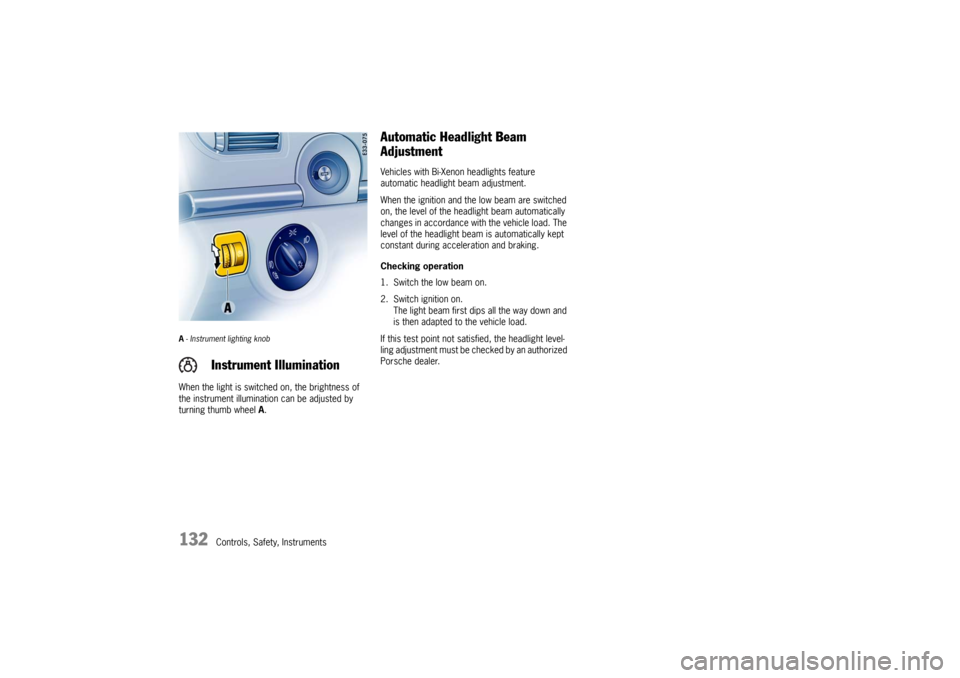
132
Controls, Safety, Instruments
A- Instrument lighting knobWhen the light is switched on, the brightness of
the instrument illumination can be adjusted by
turning thumb wheel A.
Automatic Headlight Beam
AdjustmentVehicles with Bi-Xenon headlights feature
automatic headlight beam adjustment.
When the ignition and the low beam are switched
on, the level of the headlight beam automatically
changes in accordance with the vehicle load. The
level of the headlight beam is automatically kept
constant during acceleration and braking.
Checking operation
1. Switch the low beam on.
2. Switch ignition on.
The light beam first dips all the way down and
is then adapted to the vehicle load.
If this test point not satisfied, the headlight level-
ling adjustment must be checked by an authorized
Porsche dealer.
Instrument Illumination
Page 133 of 387
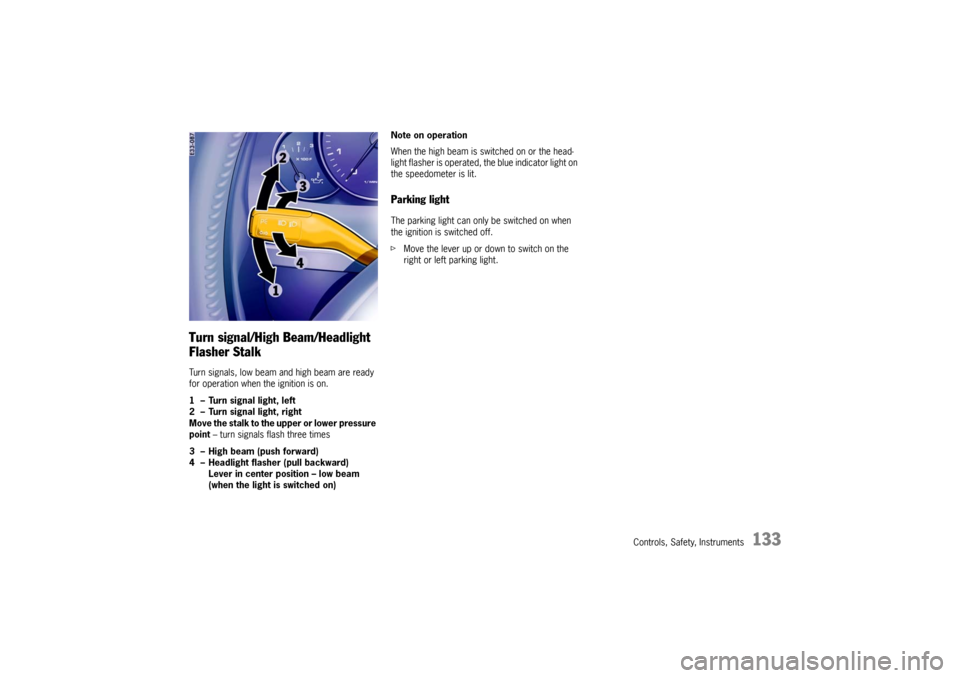
Controls, Safety, Instruments
133
Turn signal/High Beam/Headlight
Flasher StalkTurn signals, low beam and high beam are ready
for operation when the ignition is on.
1 – Turn signal light, left
2 – Turn signal light, right
Move the stalk to the upper or lower pressure
point – turn signals flash three times
3 – High beam (push forward)
4 – Headlight flasher (pull backward)
Lever in center position – low beam
(when the light is switched on)Note on operation
When the high beam is switched on or the head-
light flasher is operated, the blue indicator light on
the speedometer is lit.
Parking lightThe parking light can only be switched on when
the ignition is switched off.
fMove the lever up or down to switch on the
right or left parking light.
Page 134 of 387
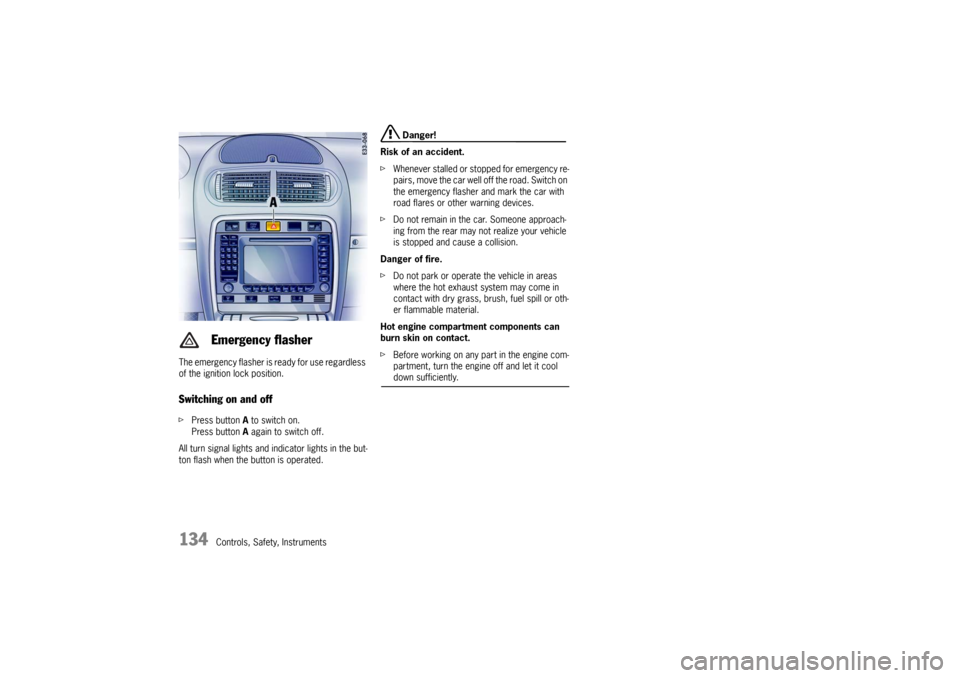
134
Controls, Safety, Instruments The emergency flasher is ready for use regardless
of the ignition lock position.
Switching on and offfPress button A to switch on.
Press button A again to switch off.
All turn signal lights and indicator lights in the but-
ton flash when the button is operated.
Danger!
Risk of an accident.
fWhenever stalled or stopped for emergency re-
pairs, move the car well off the road. Switch on
the emergency flasher and mark the car with
road flares or other warning devices.
fDo not remain in the car. Someone approach-
ing from the rear may not realize your vehicle
is stopped and cause a collision.
Danger of fire.
fDo not park or operate the vehicle in areas
where the hot exhaust system may come in
contact with dry grass, brush, fuel spill or oth-
er flammable material.
Hot engine compartment components can
burn skin on contact.
fBefore working on any part in the engine com-
partment, turn the engine off and let it cool down sufficiently.
Emergency flasher
Page 135 of 387
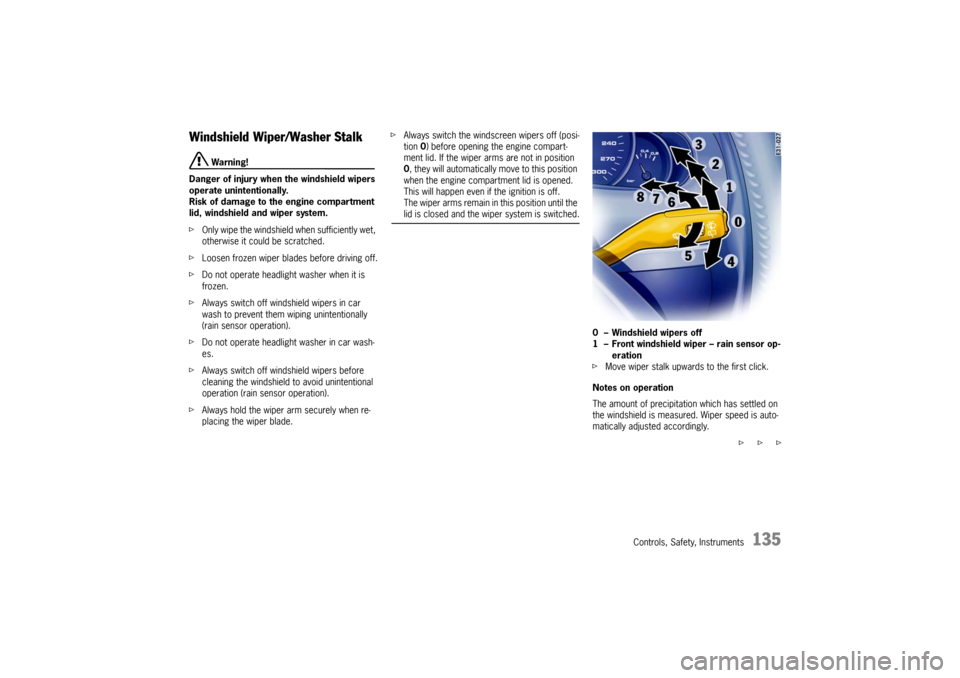
Controls, Safety, Instruments
135
Windshield Wiper/Washer Stalk
Warning!
Danger of injury when the windshield wipers
operate unintentionally.
Risk of damage to the engine compartment
lid, windshield and wiper system.
fOnly wipe the windshield when sufficiently wet,
otherwise it could be scratched.
fLoosen frozen wiper blades before driving off.
fDo not operate headlight washer when it is
frozen.
fAlways switch off windshield wipers in car
wash to prevent them wiping unintentionally
(rain sensor operation).
fDo not operate headlight washer in car wash-
es.
fAlways switch off windshield wipers before
cleaning the windshield to avoid unintentional
operation (rain sensor operation).
fAlways hold the wiper arm securely when re-
placing the wiper blade.fAlways switch the windscreen wipers off (posi-
tion 0) before opening the engine compart-
ment lid. If the wiper arms are not in position
0, they will automatically move to this position
when the engine compartment lid is opened.
This will happen even if the ignition is off.
The wiper arms remain in this position until the
lid is closed and the wiper system is switched.
0 – Windshield wipers off
1 – Front windshield wiper – rain sensor op-
eration
fMove wiper stalk upwards to the first click.
Notes on operation
The amount of precipitation which has settled on
the windshield is measured. Wiper speed is auto-
matically adjusted accordingly.
f f f
Page 136 of 387
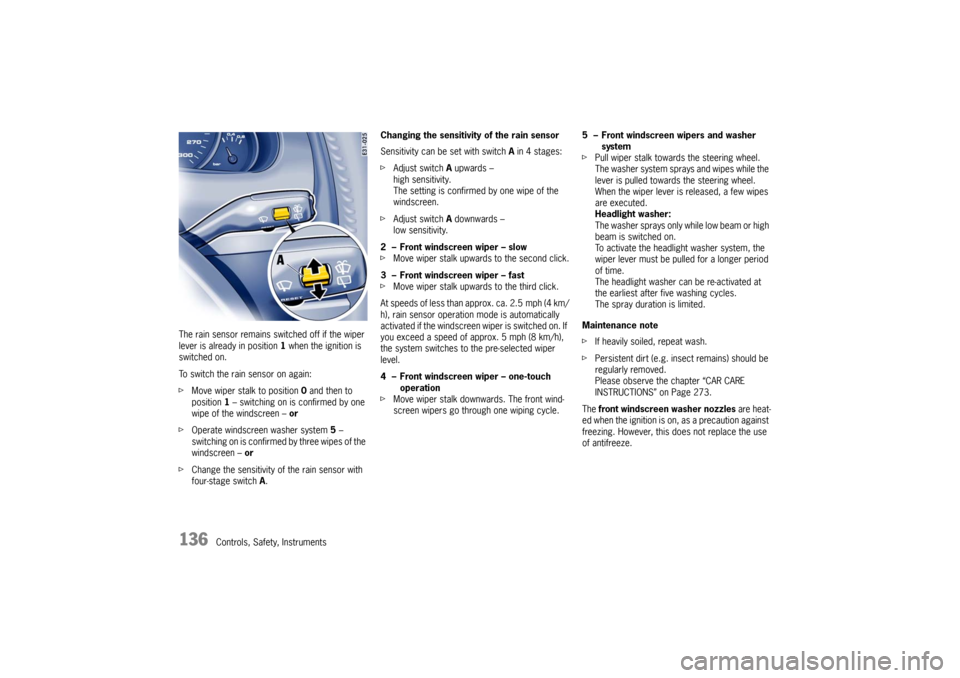
136
Controls, Safety, Instruments The rain sensor remains switched off if the wiper
lever is already in position 1 when the ignition is
switched on.
To switch the rain sensor on again:
fMove wiper stalk to position 0 and then to
position 1 – switching on is confirmed by one
wipe of the windscreen – or
fOperate windscreen washer system 5 –
switching on is confirmed by three wipes of the
windscreen – or
fChange the sensitivity of the rain sensor with
four-stage switch A.Changing the sensitivity of the rain sensor
Sensitivity can be set with switch A in 4 stages:
fAdjust switch A upwards –
high sensitivity.
The setting is confirmed by one wipe of the
windscreen.
fAdjust switch A downwards –
low sensitivity.
2 – Front windscreen wiper – slow
fMove wiper stalk upwards to the second click.
3 – Front windscreen wiper – fast
fMove wiper stalk upwards to the third click.
At speeds of less than approx. ca. 2.5 mph (4 km/
h), rain sensor operation mode is automatically
activated if the windscreen wiper is switched on. If
you exceed a speed of approx. 5 mph (8 km/h),
the system switches to the pre-selected wiper
level.
4 – Front windscreen wiper – one-touch
operation
fMove wiper stalk downwards. The front wind-
screen wipers go through one wiping cycle.5 – Front windscreen wipers and washer
system
fPull wiper stalk towards the steering wheel.
The washer system sprays and wipes while the
lever is pulled towards the steering wheel.
When the wiper lever is released, a few wipes
are executed.
Headlight washer:
T h e w a s h e r s p r a ys o n l y w h i l e l o w b e a m o r h i g h
beam is switched on.
To activate the headlight washer system, the
wiper lever must be pulled for a longer period
of time.
The headlight washer can be re-activated at
the earliest after five washing cycles.
The spray duration is limited.
Maintenance note
fIf heavily soiled, repeat wash.
fPersistent dirt (e.g. insect remains) should be
regularly removed.
Please observe the chapter “CAR CARE
INSTRUCTIONS” on Page 273.
The front windscreen washer nozzles are heat-
ed when the ignition is on, as a precaution against
freezing. However, this does not replace the use
of antifreeze.
Page 137 of 387

Controls, Safety, Instruments
137
6 – Rear window wiper – intermittent
operation
fMove wiper stalk forwards to the first click.
The rear window wiper wipes at preset inter-
vals.
7 – Rear window wiper – one-touch
operation
fPush wiper stalk forward briefly. The washer
system sprays and the rear window wiper goes
through three wipe cycles.
8 – Rear window wiper and washer system
Push wiper stalk forwards as far as it will go.
The washer system sprays and wipes while the le-
ver is pulled away from the steering wheel. When
the wiper lever is released, a few drying wipes are
executed.Maintenance note
If the wiper blades rub or squeak, this can be as a
result of the following:
– If the vehicle is washed in an automatic car
wash, residues may adhere to the windshield.
These residues can only be removed using a
special cleaning solution.
Please contact your authorized Porsche dealer
for further information.
– The wiper blades may be damaged or worn.
fReplace the damaged wiper blades
immediately.
Page 138 of 387
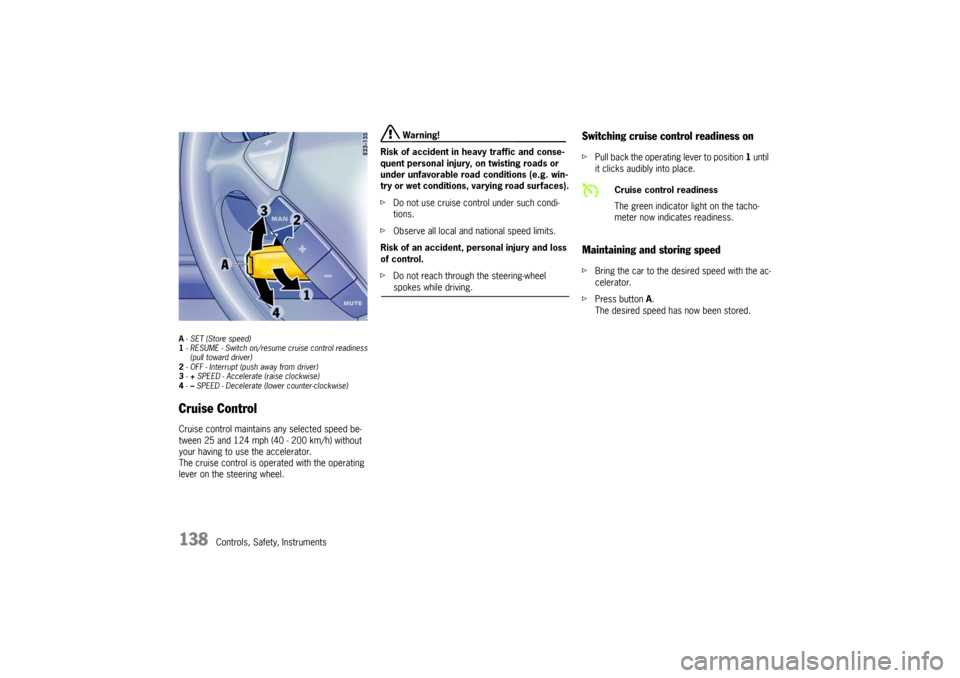
138
Controls, Safety, Instruments
A- SET (Store speed)
1- RESUME - Switch on/resume cruise control readiness
(pull toward driver)
2- OFF - Interrupt (push away from driver)
3-+ SPEED - Accelerate (raise clockwise)
4-– SPEED - Decelerate (lower counter-clockwise)Cruise ControlCruise control maintains any selected speed be-
tween 25 and 124 mph (40 - 200 km/h) without
your having to use the accelerator.
The cruise control is operated with the operating
lever on the steering wheel.
Warning!
Risk of accident in heavy traffic and conse-
quent personal injury, on twisting roads or
under unfavorable road conditions (e.g. win-
try or wet conditions, varying road surfaces).
fDo not use cruise control under such condi-
tions.
fObserve all local and national speed limits.
Risk of an accident, personal injury and loss
of control.
fDo not reach through the steering-wheel spokes while driving.
Switching cruise control readiness onfPull back the operating lever to position 1 until
it clicks audibly into place.Maintaining and storing speedfBring the car to the desired speed with the ac-
celerator.
fPress button A.
The desired speed has now been stored.
Cruise control readiness
The green indicator light on the tacho-
meter now indicates readiness.
Page 139 of 387

Controls, Safety, Instruments
139
Accelerating (e.g. to overtake)Option 1
fIncrease the speed as usual with the accelera-
tor.
When you ease off the accelerator, the previ-
ously stored value is set again.
Option 2
fPush operating lever upwards into position 3
until the desired speed is reached.
The speed reached is maintained and stored
when the operating lever is released.
Option 3
fPush operating lever slightly upwards into po-
sition 3 (a maximum of 10 times).
The speed is increased by 1 mph (2 km/h).
Note on operation
Cruise control operation is automatically interrupt-
ed if the speed is increased by more than approx.
16 mph (25 km/h) for longer than 20 seconds.
DeceleratingOption 1
fPush operating lever down into position 4 until
the desired speed is reached.
The speed reached is maintained and stored
when the operating lever is released.
Option 2
fPush operating lever slightly downwards into
position 4 (a maximum of 10 times).
The speed is reduced by 1 mph (2 km/h).
Interrupting cruise control operationThe speed driven before the interruption remains
stored in the memory.
fPush forward the operating lever to position 2
(it doesn’t engage) or
fPress brake pedal or
fSwitch selector lever to position N.
fPlease observe the chapter “TIPTRONIC S” on
Page 214.
Cruise control operation is interrupted
automatically:
– If the set vehicle speed is exceeded by more
than approx. 16 mph (25 km/h) for longer than
20 seconds.
– If the actual vehicle speed falls by approx.
6 mph (10 km/h) below the set vehicle speed
for longer than 5 seconds (e.g. upward
slopes).
– If Porsche Stability Management (PSM) inter-
venes for longer than 0.2 seconds.
– If Low Range is switched on.
Page 140 of 387

140
Controls, Safety, Instruments
Resuming the stored speedfPull back the operating lever to position 1.
Note on operation
The stored speed should only be recalled when
traffic conditions and the road surface so permit.Switching cruise control readiness offfPush forward the operating lever to position 2
until it clicks audibly into place.
The memory is cleared and the green
readiness light goes out.
When the vehicle is parked and the ignition
switched off, the memory is cleared.
Tip on driving
On upward or downward slopes, the set speed
cannot always be maintained by cruise control.
fTo obtain sufficient engine braking or a better
engine-speed range, therefore, you have to
change down to a lower gear.